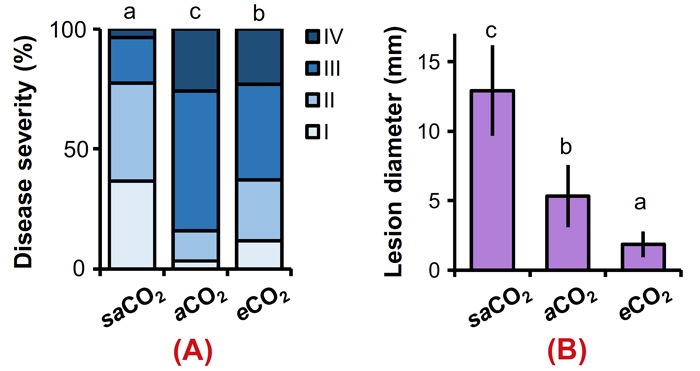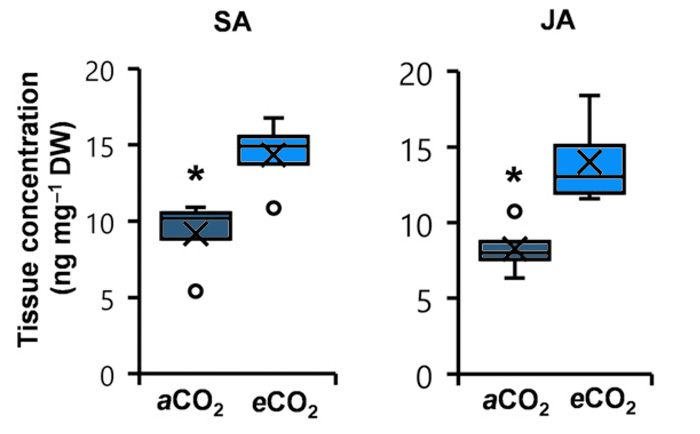| Tweet | Follow @co2science |
Paper Reviewed
Williams, A., Pétriacq, P., Schwarzenbacher, R.E., Beerling, D.J. and Ton, J. 2018. Mechanisms of glacial-to-future atmospheric CO2 effects on plant immunity. New Phytologist 218: 752-761.
In an intriguing new study, Williams et al. (2018) examined the impacts of both elevated and sub-ambient atmospheric CO2 concentrations on plant immunity. Previous research has shown that plant metabolism is directly influenced by atmospheric CO2 concentration, with many studies indicating that plant pathogen activity is suppressed at higher atmospheric CO2 levels (see, for example, the several studies we have reviewed and archived on this topic in our Subject Index under the heading Pathogens).
For their contribution to this emerging field of research, Williams et al. performed a combination of (1) gene expression analysis, (2) phenotypic characterization of mutants and (3) mass spectrometry-based metabolic profiling on Arabidopsis thaliana plants infected with two plant pathogens: the biotrophic oomycete Hyaloperonospora arabidopsidis (Hpa) and the necrotrophic fungus Plectosphaerella cucumerina (Pc). The plants were reared in controlled environment chambers at three CO2 levels (200, 400 and 1200 ppm, corresponding to sub-ambient, ambient and elevated values). Pathogen inoculation was induced at the eight-leaf stage for Hpa and at the 18-leaf stage for Pc.
The plant development-independent effects of atmospheric CO2 are shown in the Figure below (Panel A for Hpa and Panel B for Pc). As indicated there, both sub-ambient and elevated CO2 levels suppressed Hpa severity relative to ambient CO2 concentrations. In contrast, Pc infection declined as the atmospheric CO2 treatment level increased; being the high highest in the sub-ambient treatment and lowest in the elevated treatment.
With respect to the potential causes of the above findings, Williams et al. report that their several analyses revealed that resistance to Pc and Hpa at elevated CO2 was likely related to "enhanced basal production of salicylic acid (SA) and jasmonic acid (JA) (Figure 2), causing priming of JA- and SA-dependent gene expression," where they note that "comparison to plants at ambient CO2, plants at elevated CO2 showed a 69.3% and 69.4% increase in accumulation of SA and JA, respectively." Resistance to Hpa at sub-ambient CO2, in contrast, was induced by an "enhanced accumulation of intracellular reactive oxygen species, mediating enhanced levels of SA-independent resistance in comparison to ambient CO2-exposed plants."
In light of the above, it is clear that elevated CO2 is capable of inducing direct immunological effects that enhance plant immunity, thereby fortifying them against destructive pathogen attacks.

Figure 1. Effects of sub-ambient (saCO2; 200 ppm), ambient (aCO2; 400 ppm) and elevated (eCO2; 1200 ppm) CO2 concentrations on developmentally-corrected plant basal resistance of Arabidopsis thaliana against biotrophic Hyaloperonospora arabidopsidis (Hpa; Panel A) and necrotrophic Plectosphaerella cucumerina (Pc; Panel B). Shown are relative numbers of leaves (n > 50) in Hpa colonization classes of increasing severity (I-IV) at 6 days post-inoculation (dpi), or average lesion diameters (± SD; n = 8) by Pc at 13 dpi. Different letters indicate statistically significant differences (Fisher's exact test; ANOVA with Tukey honest significant difference post-hoc analysis; P < 0.05). Source: Williams et al. (2018).

Figure 2. Accumulation of salicylic (SA) and jasmonic (JA) acids in Arabidopsis of similar developmental stage (eight-leaf) at ambient (aCO2; 400 ppm) and elevated (eCO2; 1200 ppm) CO2. Shown are box plots of replicated metabolite quantifications (n = 5; means are indicated by X; outliers outside the 2.5-97.5 percentile interval are indicated by o). Source: Williams et al. (2018).




